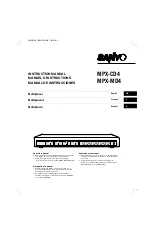
3B SCIENTIFIC® PHYSICS
1
Digital Multimeter E 1006809
Instruction sheet
11/14 SD/UD
1 Measuring probe
1a Finger guards
2 Measurement socket “20 A”
for current measurement in
20-A range (positive)
3 Measurement socket “A” for
current measurement for up to
2 A (positive)
4 Measurement socket “COM“
(negative)
5 Measurement socket “V/
Ω
“ for
voltage and resistance meas-
urement (positive)
6 Transistor test socket
7 Measurement range dial
8 Hold function button
9 On/Off switch
10 Display
11 Unlock button
1. Safety instructions/using the equipment safely
Digital multimeter E is designed to display elec-
trical measurements in the ranges and meas-
urement environments specified in its technical
data.
It conforms to safety regulations for electrical
measurement, control and laboratory equip-
ment, as specified in DIN EN 61010-1, protec-
tion class 2 and to excess voltage category CAT I
for up to 1000 V. It is intended for measurements
on experiments and laboratory apparatus. It is
not
approved for measurements on low-voltage
mains distribution equipment, such as sockets,
fuses, etc.
CAT I: Signal layer, telecommunications, elec-
tronic equipment with only minor excess voltage
transients
CAT II: domestic appliances, mains sockets,
portable instruments etc.
CAT III: Supply via buried cabling, built-in swit-
ches, automatic circuit breakers, sockets or
contactors
CAT IV: Equipment and installations supplied,
for example, by overhead mains cables and
therefore subject to greater risk of lightning
strikes. This includes, for example, main swit-
ches at the building mains feed, electricity me-
ters and ripple control receivers.
Safe operation of the multimeter is guaranteed if
it is solely used as specified. Safety cannot be
guaranteed, however, if the multimeter is used
incorrectly or handled without due care and at-
tention. In order to avoid serious injury due to
current or voltage shocks, the following safety
instructions are to be observed at all times:
•
Carefully read the instruction manual before
using the multimeter and obey the instruc-
tions therein.
•
The multimeter may only be used by per-
sons who are able to recognise the risks of
contact and take due precautions to avoid
them.
This multimeter is not a toy and must not fall into
the hands of children.
•
Do not place it, keep it or use it anywhere
within reach of children.
•
When the multimeter is used by teenagers,
trainees etc., a suitable person should su-
pervise to ensure the equipment is used
safely.
•
If measurements are made where there are
any risks of coming into contact with electric-
ity, a second person is to be informed.























